- Home
- Stephen E. Ambrose
Ike's Spies: Eisenhower and the Espionage Establishment Page 7
Ike's Spies: Eisenhower and the Espionage Establishment Read online
Page 7
The reason for the lack of an investigation, according to Rosfelder, was plain. The authorities, Rosfelder noted, “showed an evident willingness to minimize the whole affair.” For this phenomenon, Rosfelder said, “there is only one explanation: five or six political or patriotic groups had Darlan in their sights and each one believed for quite some time that it was ‘his’ plot that had succeeded.” Indeed, the police superintendent “had even pushed his obligingness to the point of burning all our files … still another who believed in the success of ‘his’ plot!”33
It was indeed true that few men ever had more enemies than Darlan, which opened the way to wild speculation in the world press about who was behind Bonnier. The Germans said the British Secret Service did it in order to forestall American influence in North Africa. Nazi radio stations claimed that Darlan’s last words were, “Now the British have succeeded in reaching their goal.” From Italy, Radio Rome declared that the conspirators were “French de Gaullists in the pay of the British intelligence service.”34 The Spanish press blamed Vichy. The New York Times said Bonnier was an Italian.35
Colonel Eddy, meanwhile, dispersed the OSS agents working with Corps Franc d’Afrique for fear they would be implicated. Eddy sent Major Carleton Coon, who was in charge of the unit Bonnier belonged to, off to Tunisia before he could be accused of collusion in the murder.36
At the same time, Ike was trying to manipulate the French so that all Frenchmen outside of Vichy could join together to fight the Nazis, which meant in the first instance a rapprochement between Giraud and de Gaulle. De Gaulle wanted to come to North Africa, and Ike tried to convince Giraud to allow him to do so. But on December 27, Giraud told Ike that de Gaulle should wait until the political and military situation in North Africa had become more settled.37 Eisenhower agreed to wait, and on December 28 he wired Churchill, “I believe that Giraud will serve as the medium through which the desired rapprochement can soon be effected if the matter is not pressed too precipitately.”38
The next evening, December 29, a highly agitated OSS officer rushed into PWB headquarters to announce breathlessly, “They’ve arrested all our friends!”39 Algiers was in an uproar as squads of Vichy police descended on their victims at their homes, handcuffed them, and whisked them out of the city. One rumor had it that only Gaullists were being arrested; another held that it was Dubreuil and his gang. Twelve men were arrested; four were police officers, and two or three were said to have helped the Americans land.
Charles Collingwood of CBS interviewed Giraud, who told him that the conspirators who had murdered Darlan also intended to assassinate Giraud and Murphy. Giraud said the arrested men were being held in preventive arrest and would not be executed. “We have arrested people who helped the Americans to land and those who helped the Germans,” Giraud told Collingwood, “as well as those police who knew of the plot against Darlan but did not tell their superiors. I am following the French thesis that it is better to prevent than to punish.”
Collingwood asked about the policemen who had been arrested. “They knew that Darlan was going to be murdered and did not warn their superiors. I did not want to start that again. I only carried out the arrests when I knew beyond doubt that there were to be other assassinations.”40
The OSS had different explanations of what happened and why. One agent reported that Dubreuil and the Cagoulards had attempted a royalist coup d’etat.41 Agent Taylor believed that all those arrested were Gaullists who had supported the American landings. He protested through “every bureaucratic channel, political and military, formal and informal, in a vain attempt to make Eisenhower realize the catastrophic effect on world opinion if we tolerated this vindictive Vichy counteroffensive against the underground allies who had risked their lives in our common cause a few weeks earlier.”
But Ike refused to act. Taylor went to Murphy. Surely Murphy would not allow the very men he had conspired with in October to be arrested on the pretext that they had designs on his life? To Taylor’s amazement, Murphy gave the same reply Ike had used: he could not interfere in an internal French matter. Taylor’s bitter conclusion was, “Darlan had been our son-of-a-bitch, and Giraud was now, and whoever was against an officially approved son-of-a-bitch must ipso facto be against us.”
Taylor turned his PWB headquarters at the Hotel de Cornouailles into a sanctuary for Frenchmen being hunted by the Algiers police. One of the refugees was the head of that police force, but Henri d’Astier had learned that his own police agents were looking for him, supposedly with orders to shoot on sight. Taylor gave d’Astier a PWB jeep to take him to the cathedral for mass. Two weeks later d’Astier was arrested.42
Giraud had thrown a wide net, as he had indicated to Collingwood, arresting men of all political persuasions and backgrounds. By so doing, he implicated everybody in Darlan’s murder, which may very well have been his objective, as it is probable that he himself did not know who the successful conspirators were, but assumed it could have been any one of a half-dozen groups.43
Within a year, after de Gaulle and Giraud had achieved their rapprochement, they joined hands to make Bonnier into a hero. On the first anniversary of his execution, according to the Associated Press, “a group of about 50 persons, the majority of whom fill official positions under the orders of Generals Giraud and de Gaulle, celebrated the anniversary of the death of Fernand Eugene Bonnier de la Chapelle, who assassinated Admiral Darlan, by placing a wreath on his tomb and observing a minute of silence.”
That incredible scene was followed up a week later by an incredible act—the Algerian Court of Appeals, under de Gaulle’s control, annulled the sentence against Bonnier, citing as its reason “documents found which showed conclusively that Admiral Darlan had been acting against the interests of France and that Bonnier’s act had been accomplished in the interests of the liberation of France.”
Bonnier’s crime disappeared from the record. As a consequence, so did that of any of his accomplices and the case was closed. Shortly thereafter, Henri d’Astier and his associates were released; the day he got out of jail, d’Astier received the Croix de Guerre with palms from Giraud, and the following day the Medal of the Resistance from de Gaulle. Two days later de Gaulle named him a member of the Consultative Assembly.44
Because of these actions, and because de Gaulle benefited so immediately and decisively from Darlan’s removal, most commentators have pointed to him as the ultimate source of the conspiracy. But although both Giraud and de Gaulle were delighted to have Darlan out of the way and made no effort to hide their pleasure, they were not necessarily in on the plot, either together or as individuals. Rosfelder’s confession, published thirty years after the event, and confirmed by much other evidence gathered in that time,45 raises many questions about the ultimate conspirators. Certainly Abbé Cordier was at the heart of it, and he worked for d’Astier, who worked for Dubreuil. And beyond Dubreuil? Another Frenchman? Or perhaps an American?
The ultimate source of authority in North Africa was Franklin Roosevelt. He put it bluntly when he cabled Churchill on January 2, 1943, “I feel very strongly that, in view of the fact in North Africa we have a military occupation, our commanding general has complete control of all affairs, both civil and military. Our French friends must not be permitted to forget this for a moment. If these local officials will not cooperate, they will have to be replaced.”46
Robert Murphy was the President’s personal representative in North Africa, as well as head of an OSS organization that included Major Coon’s Corps Franc, of which Bonnier was a member, and Taylor’s PWB, which had close contacts with d’Astier. Further, Murphy was a close friend of Dubreuil and had made a strong commitment to Giraud, while he detested de Gaulle (as did Roosevelt). The question arises, was Murphy a part of the conspiracy? Was Darlan’s murder the first assassination for the American secret service? Was Ike himself in on the plot? Does that explain the rather curious circumstance that at the moment the murder was committed the commanding general of all Alli
ed operations in North Africa was at a corps headquarters on a farm more than a day’s drive from Algiers?
At the time, in 1942, few Americans would have believed it possible for their government to be involved in such dastardly work; a generation later, however, millions of Americans would take it for granted that if there was foul play and the predecessor of the CIA was in the area, and if the Americans benefited from the foul play, then the OSS must have been involved. These questions also persist because of Murphy’s continued association with Dubreuil, whose hopes to become finance minister and the real power in a Giraud government (or prime minister under the Comte de Paris) disappeared when Giraud and de Gaulle got together in January 1943. De Gaulle despised Dubreuil as a collaborator. When de Gaulle emerged in the spring of 1943 as the head of government in Algiers, Dubreuil fled to Spain, where he joined a number of his old associates from the Cagoule.47 In 1944, following the liberation of France, Dubreuil slipped across the border. He was promptly arrested by French police on charges of having “negotiated with a foreign power.”48
Murphy used his position as Ike’s chief political adviser to persuade the French to drop the charges against Dubreuil and held a party in Paris in celebration of Dubreuil’s freedom.49 After the war, Murphy refused to discuss his loyalty to Dubreuil or events surrounding the murder of Darlan,* but in his memoirs he made the astonishing statement that “the motive for the assassination of Darlan still remains a mystery.”50 In 1947, Dubreuil was tried for treason but acquitted; on July 12, 1955, he was shot to death by unknown assailants for unknown reasons on the doorstep of his Casablanca home.51
Murphy’s loyalty to Dubreuil aside, the fact that the Americans benefited so directly from Darlan’s death makes them at least suspect. Clark, in his memoirs, published in 1950, added to the suspicion because he expressed such delight over the assassination. “Admiral Darlan’s death was, to me, an act of Providence. It is too bad that he went that way, but, strategically speaking, his removal from the scene was like the lancing of a troublesome boil. He had served his purpose, and his death solved what could have been the very difficult problem of what to do with him in the future. Darlan was a political investment forced upon us by circumstances, but we made a sensational profit in lives and time through using him.”52
That almost sounds like a confession, but despite Clark’s carelessly chosen words, and despite speculation linking Murphy with the conspirators, there is no direct evidence connecting Eisenhower, his chief subordinates, or the OSS with the murder of Darlan. Eisenhower’s attitude was best expressed by his reaction to Roosevelt’s message saying that if the French leaders would not cooperate “they will have to be replaced.” Ike was terribly upset, according to Butcher. He said that without the good will of the French Army, the Americans would have to take on the “man-wasting” job of providing civil administration for Algeria and guarding the lines of communication through North Africa. Instead of active assistance from the French, Ike said he feared there would be “passive resistance à la Ghandi, or possibly resumption of French fighting Americans ‘pour l’honneur.’ ”
If FDR insisted on dictating to the French to the point that it brought on French resistance, Butcher noted, “Ike said he would of course carry out the order, but would then ask to be relieved, which would no doubt mean reversion to the rank of lieutenant colonel, and retirement.”53 Ike had come to admire Darlan and appreciate his cooperative spirit. He did not put the finger on the man.
Neither did Murphy or the OSS, if only because they did not have to do so. Anyone living in Algiers in December 1942 would have had to have been deaf and blind not to know that there were numerous plots to kill the little admiral. The analogy that fits is Saigon in 1963, where the CIA did not have to lift a hand against Diem but simply stood aside and let the South Vietnamese themselves do the killing. As Rosfelder makes so abundantly clear, in Algiers there were plenty of Frenchmen on the prowl for Darlan. And as de Gaulle’s and Giraud’s actions after the event indicate, there were many highly placed Frenchmen who were delighted to have the admiral out of the way, so much so that they made a hero out of the murderer.
* * *
* The admiral was in Algiers because his secret service had tipped him off that the invasion was imminent.
* Darlan did order Admiral Esteva to use the fleet to resist, but the French Army in Tunisia, under General Georges Barre, had withdrawn into the mountains, refusing either to fight the Germans or to follow Vichy orders to collaborate with them. The Germans were already arriving. Esteva decided to do nothing. The main French fleet, meanwhile, at Toulon, had scuttled itself rather than sail to join the Allies or be taken over by the Germans.
* Putting it the other way around, Murphy’s and Clark’s failure to coordinate with the French had cost 1,800 American lives.
* According to Michael R. D. Foot, SOE in France (a British official history, published in 1966), “members of d’Astier’s Algiers group had drawn lots for which of them should have the honour of killing the admiral,” but French sources do not support his statement. Mario Faivre supports Rosfelder in his own confession, Nous avons tue l’Admiral Darlan (Paris, 1976).
* At least with this author, who asked on a number of occasions in the 1960s. Carleton Coon also refused three separate requests for an interview made in 1979.
CHAPTER FIVE
Ike and ULTRA in Africa, Sicily, and Italy
FEBRUARY, 1942. A fox brought to bay by a pack of hounds is a fearful sight, snarling, snapping, turning left, right, backward, never resting, always alert. The fox is the dreaded Erwin Rommel and his famous Afrika Korps; the hounds are Montgomery’s Eighth Army, pursuing from the east, the American II Corps (General Lloyd Fredendall) closing in from the west, the French from the northwest, and the British First Army (General Kenneth Anderson) covering the northern escape route.
ROMMEL had just retreated across half of North Africa, following his defeat by the British at El Alamein in November 1942. When he reached the Mareth Line, a prepared defensive position, partly underground, along the Tunisian-Libyan border, Rommel turned on the British, who recoiled, then settled down to await reinforcements. The chase across Africa had been exhilarating, but to close in on the “Desert Fox” in his den was another matter altogether. Monty gave Rommel time to catch his breath and plan his next move.
The American II Corps was to Rommel’s west and north, stretched out along the eastern dorsal of the Atlas Mountains. The front line was too long for the Americans to hold in strength, but neither Fredendall nor Eisenhower were overly worried. Intelligence indicated that any German attack would come from north of the II Corps line at Fondouk, which was a British and French responsibility.
According to Ike’s intelligence reports, Rommel was fully occupied by Monty, so General Jürgen von Arnim, who commanded the German forces in Tunis, would lead the offensive. Ike’s G-2 (intelligence) officer at Allied Force Headquarters (AFHQ) was British Brigadier Eric E. Mockler-Ferryman. He reported that all available information indicated that von Arnim was going to draw on Rommel’s Africa Korps for reinforcements, then attack through a pass at Fondouk, with the aim of scattering the French, then turning north, driving to the coast, to isolate Anderson’s First Army.1
Eisenhower did not fully accept Mockler-Ferryman’s judgment, but he did not have sufficient self-confidence to overrule his G-2. He was worried enough to go to the front to oversee preparations to meet von Arnim’s attack. On February 13–14 he made an all-night tour of the front. He was disturbed by what he saw. The American troops were complacent, green, and unblooded. They had not received intensive training in the United States, as they were the first divisions to go to England in 1942. In November they had shipped out for North Africa, where operations were just active enough to prevent training but not enough to provide real battlefield experience. Officers and men alike showed the lack of training.2
Ike was also upset at the disposition of the 1st Armored Division, which had been split in
to two parts, Combat Command A and Combat Command B (CCA and CCB), and was therefore incapable of operating as a unit. General Anderson had insisted upon keeping CCB near Fondouk to help the British meet the expected attack from von Arnim; CCA was to the south, near Faïd Pass.
General Paul Robinett commanded CCB, and on the night of February 13–14 he insistently told Ike that he was sure Mockler-Ferryman’s information was wrong. Robinett said he did not expect an attack at Fondouk because he had sent patrols all the way across the eastern dorsal without encountering any enemy buildup. Further, air reconnaissance had failed to reveal any preparations for an attack. Robinett said he had reported this intelligence to his superiors, Generals Fredendall and Anderson, but they did not believe him. Ike said he did, and promised to change the dispositions the next day.3
After his talk with Robinett, Ike drove south for a couple of hours, then paid a visit to CCA. Everything there seemed to be in order. Just after midnight he went for a walk into the desert. The moon shone. Looking eastward, he could just make out the gap in the black mountain mass that was Faïd Pass. Nothing moved.
Shaking off the mood of the desert, Eisenhower returned to CCA headquarters and then drove toward Tebessa, Fredendall’s headquarters. He arrived three hours later, around 5:30 A.M. The Germans, he learned to his astonishment from a radio message, had attacked CCA, coming through Faïd Pass at 4:00 A.M. Reports indicated, however, that it was only a limited attack, probably designed to draw off strength from the northern end of the line. CCA said it could hold on with no difficulty. Climbing into his Cadillac, Eisenhower drove on toward his advance command post at Constantine. Along the way he stopped to visit the famous Roman ruins at Timgad and did not reach Constantine until the middle of the afternoon, St. Valentine’s Day.4

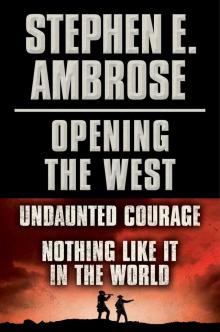 Undaunted Courage
Undaunted Courage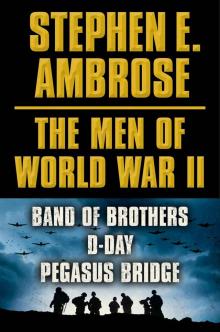 The Victors: Eisenhower and His Boys
The Victors: Eisenhower and His Boys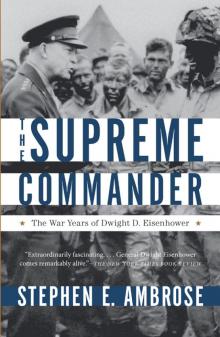 The Supreme Commander
The Supreme Commander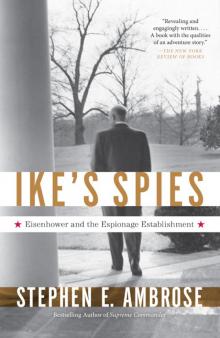 Ike's Spies: Eisenhower and the Espionage Establishment
Ike's Spies: Eisenhower and the Espionage Establishment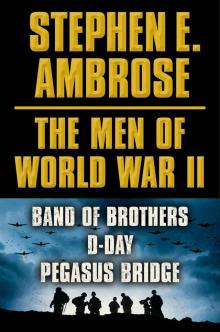 The Men of World War II
The Men of World War II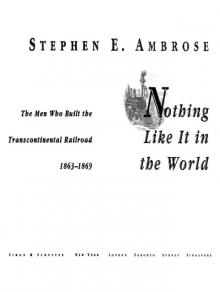 Nothing Like It in the World The Men Who Built the Transcontinental Railroad 1863-1869
Nothing Like It in the World The Men Who Built the Transcontinental Railroad 1863-1869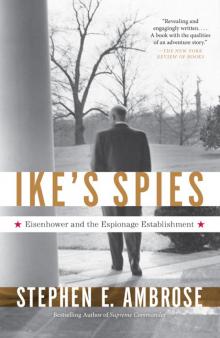 Ike's Spies
Ike's Spies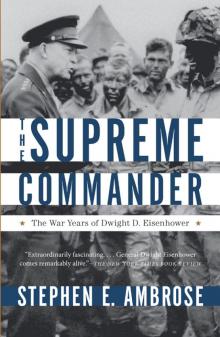 Supreme Commander
Supreme Commander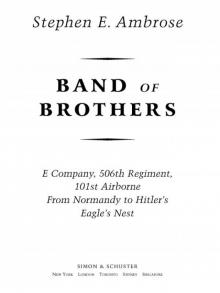 Band of Brothers
Band of Brothers